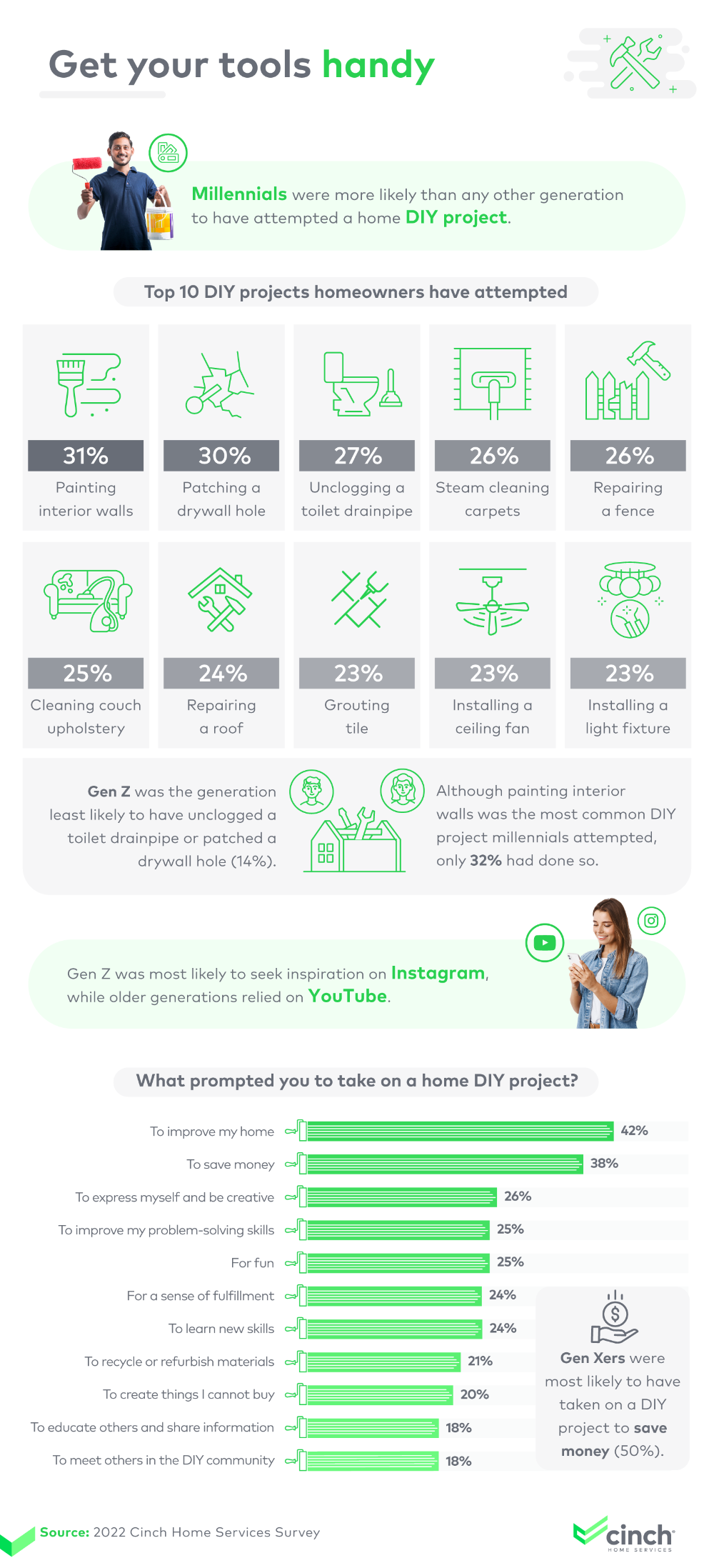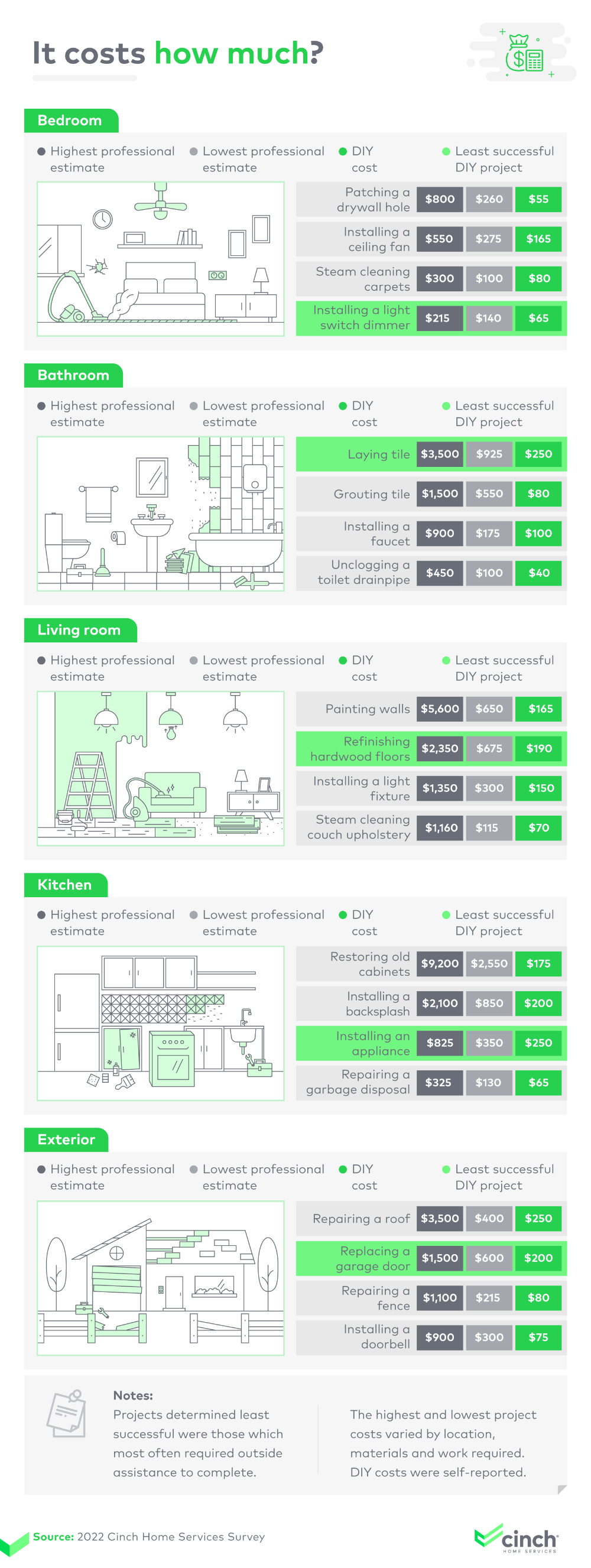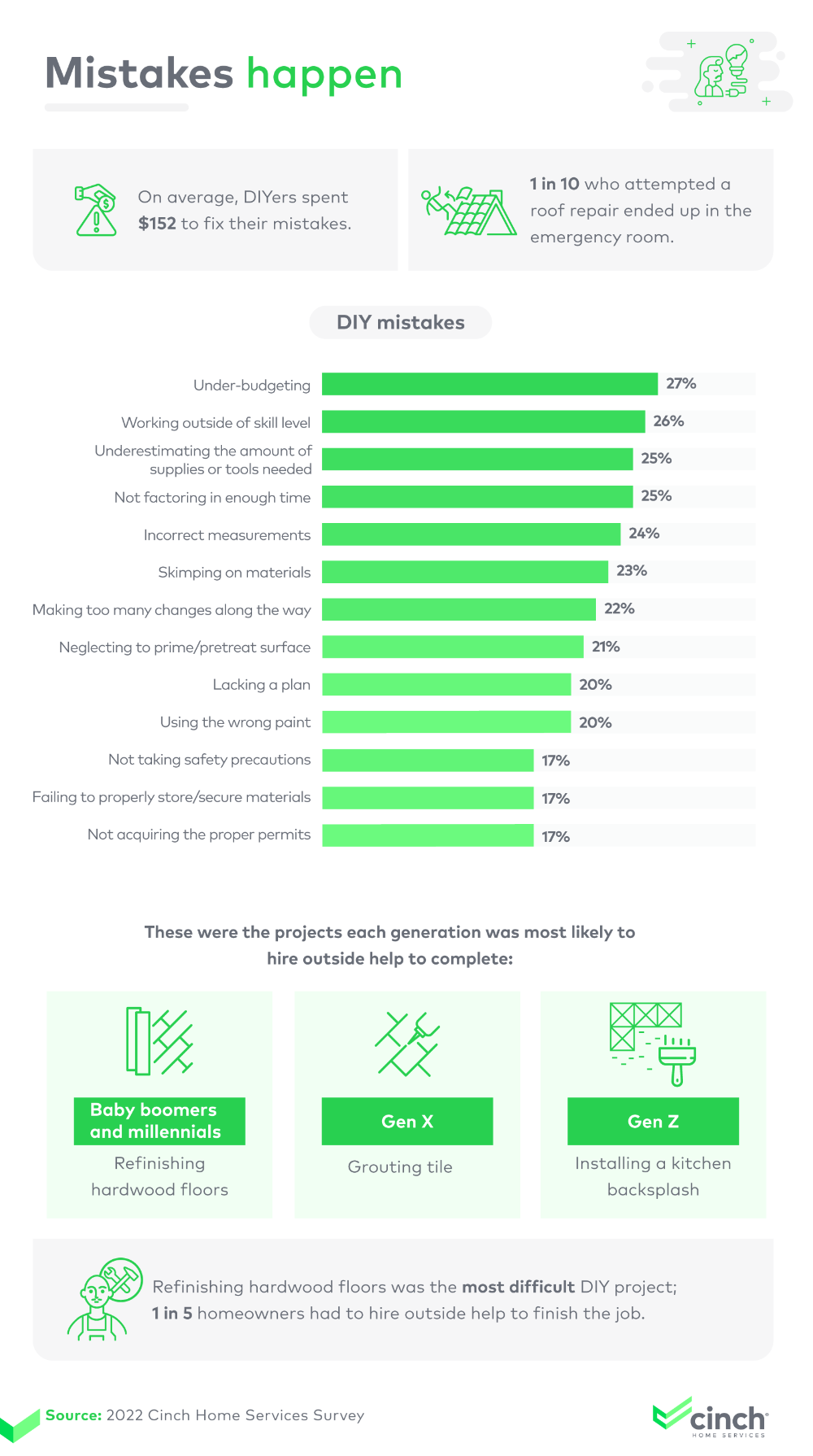DIY gone awry: Common mistakes and how to avoid them

Key takeaways:
- Millennials are the most likely generation to attempt a home DIY project.
- The most common DIY mistake is under-budgeting (27%).
- DIYers spend an average of $152 to fix their mistakes.
- One in 10 homeowners who attempt DIY roof repairs ends up in the emergency room.
- Refinishing hardwood floors is the most difficult DIY project; 1 in 5 owners had to hire outside help to finish the job.
DIY designs and disasters
Homeownership gives you the freedom to make a space your own. You can paint the walls any color you like, decorate the rooms according to your taste, and renovate any space how you see fit. All this freedom can inspire creativity and tempt homeowners to take on new projects all on their own, but do-it-yourself projects are often far more complicated than they seem on TV.
We surveyed over 1,500 homeowners about their attempted home DIY projects. From unwittingly removing load-bearing walls to mismeasuring the furniture to landing in the ER, which DIY mistakes cost owners the most money, and how can these mistakes be avoided?
Improvising home improvement
The pandemic forced people to spend more time at home than usual, and many homeowners used the opportunity to test their handiwork. What makes homeowners dive into DIY? Which projects are the most popular?

Most homeowners played things pretty safe when it came to DIY, tackling simple projects and minor repairs. Painting interior walls (31%) was the most popular DIY, followed closely by patching holes in drywall (30%). Some homeowners were a bit braver: 24% attempted roof repairs, and 23% grouted tile. The same number dealt with electrical projects, having installed ceiling fans or light fixtures.
But each generation preferred different projects:
- Baby boomers and Gen Xers seemed the handiest; 30% of baby boomers had installed a light fixture, and 26% of Gen Xers had installed a ceiling fan.
- Millennials were the most likely to attempt a home DIY project, but only 32% had painted interior walls.
- Only 14% of Gen Z had patched drywall or unclogged a toilet drainpipe.
Home improvement was the most popular reason for taking on DIY projects (42%). With the housing market surge, many homeowners made DIY upgrades to help sell their homes, while new buyers used DIY fixes for newly purchased properties. A cooling housing market might decrease the need for home improvement projects, but the rising prices from inflation may push even more homeowners to turn to DIY.
Once homeowners took on DIY projects, many turned to social media for inspiration — especially Instagram and YouTube. A few also turned to TikTok for inspiration, especially those of younger generations; Gen Z was 8% more likely than millennials to use this platform for DIY inspiration.
Time to call in the pros
As inspiring as DIY projects can be, they aren't always successful. Which ones are the most likely to require professional intervention, and what lessons have homeowners learned from DIY gone awry?

Out of all home DIY projects, refinishing hardwood floors was the most difficult to complete; 1 in five homeowners hired professional help to finish the job. Other projects that required professional support included the following (by each area of the home):
- Bedroom: Adding dimmers to light switches
- Bathroom: Laying tile
- Kitchen: Installing appliances
- Exterior: Replacing garage doors

Whether a DIY project succeeds or fails, the experience always offers lessons and advice to share. The homeowners we surveyed had plenty of advice, which trended by generation. Baby boomers advised on the importance of purchasing the proper materials and tools, while Gen Xers stressed the need to plan before beginning a project. Millennials and Gen Zers encouraged giving yourself ample time to complete a project.
Making this old house a home
Your home is an expression of who you are, and do-it-yourself projects offer a unique opportunity to truly personalize your space. That said, not every home upgrade lends itself to easy DIY. Painting walls, installing fixtures, making minor fixes and other straightforward improvements are excellent ways to spruce up your home while saving money and learning a new skill.
More complicated projects, like laying flooring, dealing with electrical circuits or making major repairs, may be worth hiring professional help to avoid disaster. But whether you take on projects yourself or outsource to the pros, a little sweat and sawdust are worth the effort if it helps turn your house into a home.
Methodology
We surveyed over 1,500 homeowners to explore their experiences with DIY projects. We also collected the highest and lowest potential prices for DIY home improvement projects by averaging project estimates from the following sources: fixr.com, homewyse.com, angi.com and homeadvisor.com. DIY prices were based on self-reports from survey respondents.
About Cinch Home Services
With more than 40 years of home industry experience, Cinch Home Services offers award-winning home warranty services in America's 48 contiguous states. Cinch has a range of plans to fit your needs, a nationwide network of service pros to ensure your repairs get done right, and an industry-leading 180-day workmanship guarantee to back it all up.
Fair use statement
Do you know a home DIY addict? Feel free to share this article with anyone you'd like. We just ask that you do so for noncommercial purposes only and provide a link to this page to give the authors their due credit.
